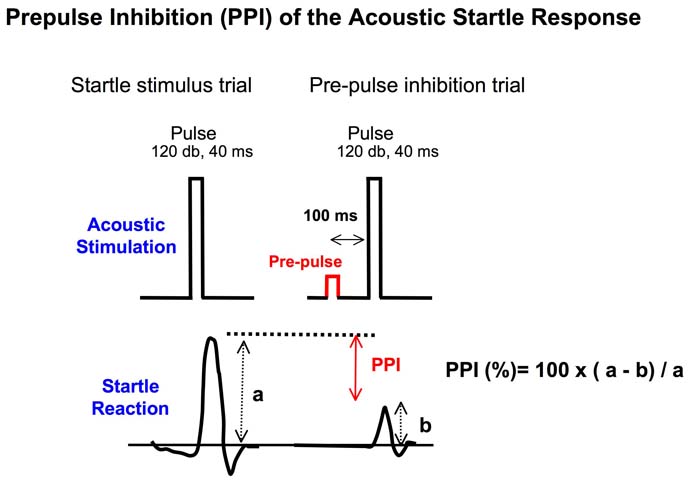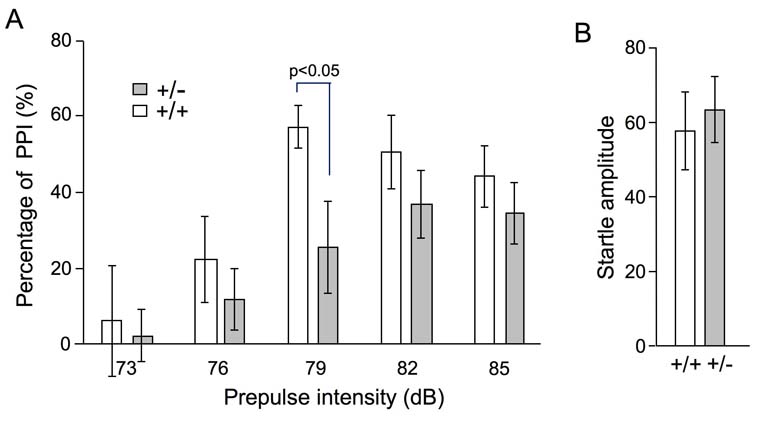Prepulse inhibition (PPI) is a physiological event that a pre-pulse (feeble pulse stimulus immediately before a pulse stimulus) suppresses responses to the pulse stimulus (startle response) and a cross-species phenomenon.
PPI deficits are observed in patients of schizophrenia1) 2) and in subjects suffering from other neuropsychiatric disorders (e.g. Huntington’s disease, pathological gambling, nocturnal enuresis, obsessive compulsive disorder, Tourette’s syndrome) also this test has been successfully in schizophrenia model rodents (PPI test is quite useful for evaluating schizophrenia model rodents and screening for antipsychotic drugs)3)-6).
Startle response is measured as movements of a cage containing mouse as whole body reaction to assess the subject's ability to "gate" or filter environmental information. |
| Category | Glycogene transgenic animals |
| Protocol Name | Prepulse inhibition (PPI) of the Acoustic Startle Response |
Authors
 |
Fukuda, Tomohiko
Division of Regulatory Glycobiology, Tohoku Pharmaceutical University
Nakagawasai, Osamu
Departments of Pharmacology, Tohoku Pharmaceutical University
Gu, Jianguo
*
Division of Regulatory Glycobiology, Tohoku Pharmaceutical University
*To whom correspondence should be addressed.
|
| KeyWords |
|
Instruments
 |
| ● |
SR(Startle Response)-LAB system (SR-LAB, San Diego Instruments, San Diego, CA) that consisted of a Plexiglas tube (105mm length; 38mm inner diameter) on a platform under which a sensitive piezoelectric sensor was mounted in a ventilated sound-attenuated test chamber with 70 dB background white noise. A piezoelectric accelerometer affixed to the animal enclosure frame was used to detect and transducer the motion that resulted from the response of the animal. |
|
| Methods |
|
1. |
The PPI protocol consists of a total of 42 trials. In the first two trials, the magnitude of the acoustic startle response to a 120 dB is measured. These first two startle tones are presented to habituate the animals to the testing procedure. Therefore, the acoustic startle response magnitude of these two trials is omitted from the statistical analysis. In the subsequent 40 trials, the trials consist of random delivery of 10 120-dB pulse alone trials, 25 pre-pulse trials and five non-stimulated trials, during which no stimuli are delivered (see Fig. 1). |
| 1) |
Animals are individually placed into Plexiglas cylinders. |
Comment 0
|

|
| 3) |
Acclimatization to the startle chamber (5 min). |
Comment 0
|

|
| 4) |
Startle stimulus.
120-dB pulse-alone startle stimuli (The startle response is recorded for 160 ms (measuring the response every 1 ms) starting with the onset of the pre-pulse stimulus.) |
Comment 0
|

|
| 5) |
Measure PPI.
Mice are presented with a 30 ms-duration 73-, 76-, 79-, 82-, or 85-dB pre-pulse (3, 6, 9, 12 or 15 dB over baseline) followed by a 50 ms 120-dB pulse 100 ms later. |
Comment 0
|

|
| 6) |
Calculate PPI.
PPI is calculated as a percentage score: PPI (%) = (startle response for pulse alone - startle response for pulse with pre-pulse) / startle response for pulse alone) X 100. |
Comment 0
|
|
|
| Figure & Legends |
Figure & Legends


Fig. 1. Illustration of how PPI is tested.


Fig. 2. Restraint stress-induced PPI deficiency in Fut8+/- mice.
Exposure to various mild stressors has been shown to activate dopamine-containing neuronal systems7). A, the effects of restraint stress (3 h) on prepulse inhibition of the startle reflex were assayed under different prepulse intensities (A) or without a prepulse (B). Of particular interest, Fut8+/- mice showed a significant PPI deficiency when presented with a 79-db prepulse, and a decrease in PPI following pre-pulses at all of other intensities compared with Fut8+/+ littermates tested under the same conditions8).
This figure was originally published in J Biol Chem. Fukuda T. et al. "Alpha1,6-fucosyltransferase-deficient mice exhibit multiple behavioral abnormalities associated with a schizophrenia-like phenotype: importance of the balance between the dopamine and serotonin systems" 2011, 286(21):18434–43. © the American Society for Biochemistry and Molecular Biology. |
| Copyrights |
 Attribution-Non-Commercial Share Alike Attribution-Non-Commercial Share Alike
This work is released underCreative Commons licenses
|
| Date of registration:2015-04-20 15:10:54 |
- Braff, D. L., Geyer, M. A., and Swerdlow, N. R. (2001) Human studies of prepulse inhibition of statle: normal subjects, patient groups, and pharmacological studies. Psychopharmacology. 156, 234–258 [PMID : 11549226]
- Kumari, V., Fannon, D., Geyer, M. A., Premkumar, P., Antonova, E., Simmons, A., and Kuipers, E. (2008) Cortical grey matter volume and sensorimotor gating in schizophrenia. Cortex. 44, 1206–1214 [PMID : 18761134]
- Ludewig, K., Geyer, M. A., and Vollenweider, F. X. (2003) Deficits in prepulse inhibition and habituation in never-medicated, first-episode schizophrenia. Biol. Psychiatry. 54, 121–128 [PMID : 12873801]
- Miyakawa, T., Leiter, L. M., Gerber, D. J., Gainetdinov, R. R., Sotnikova, T. D., Zeng, H., Caron, M. G., and Tonegawa, S. (2003) Conditional calcineurin knockout mice exhibit multiple abnormal behaviors related to schizophrenia. Proc. Natl. Acad. Sci. U.S.A. 100, 8987–8992 [PMID : 12851457]
- Moy, S. S., Perez, A., Koller, B. H., and Duncan, G. E. (2006) Amphetamine-induced disruption of prepulse inhibition in mice with reduced NMDA receptor function. Brain Res. 1089, 186–194 [PMID : 16638606]
- Stefansson, H., Sigurdsson, E., Steinthorsdottir, V., Bjornsdottir, S., Sigmundsson, T., Ghosh, S., Brynjolfsson, J., Gunnarsdottir, S., Ivarsson, O., Chou, T. T., Hjaltason, O., Birgisdottir, B., Jonsson, H., Gudnadottir, V. G., Gudmundsdottir, E., Bjornsson, A., Ingvarsson, B., Ingason, A., Sigfusson, S., Hardardottir, H., Harvey, R. P., Lai, D., Zhou, M., Brunner, D., Mutel, V., Gonzalo, A., Lemke, G., Sainz, J., Johannesson, G., Andresson, T., Gudbjartsson, D., Manolescu, A., Frigge, M. L., Gurney, M. E., Kong, A., Gulcher, J. R., Petursson, H., and Stefansson, K. (2002) Neuregulin 1 and susceptibility to schizophrenia. Am. J. Hum. Genet. 71, 877–892 [PMID : 12145742]
- Carlson, J. N., Fitzgerald, L. W., Keller, R. W., Jr., and Glick, S. D. (1991) Side and region dependent changes in dopamine activation with various durations of restraint stress. Brain Res. 550, 313–318 [PMID : 1884238]
- Fukuda, T., Hashimoto, H., Okayasu, N., Kameyama, A., Onogi, H., Nakagawasai, O., Nakazawa, T., Kurosawa, T., Hao, Y., Isaji, T., Tadano, T., Narimatsu, H., Taniguchi, N., and Gu, J. (2011) Alpha 1, 6-fucosyltransferase-deficient mice exhibit multiple behavioral abnormalities associated with a schizophrenia-like phenotype: importance of the balance between the dopamine and serotonin systems. J Biol Chem. 286, 18434-18443 [PMID : 21471224]
|
This work is licensed under Creative Commons Attribution-Non-Commercial Share Alike. Please include the following citation
How to Cite this Work in an article:
Fukuda, Tomohiko,
Nakagawasai, Osamu,
Gu, Jianguo,
(2015). GlycoPOD https://jcggdb.jp/GlycoPOD.
Web.19,4,2024 .
How to Cite this Work in Website:
Fukuda, Tomohiko,
Nakagawasai, Osamu,
Gu, Jianguo,
(2015).
Prepulse inhibition (PPI) of the Acoustic Startle Response.
Retrieved 19,4,2024 ,
from https://jcggdb.jp/GlycoPOD/protocolShow.action?nodeId=t213.
html source
Fukuda, Tomohiko,
Nakagawasai, Osamu,
Gu, Jianguo,
(2015).
<b>Prepulse inhibition (PPI) of the Acoustic Startle Response</b>.
Retrieved 4 19,2024 ,
from <a href="https://jcggdb.jp/GlycoPOD/protocolShow.action?nodeId=t213" target="_blank">https://jcggdb.jp/GlycoPOD/protocolShow.action?nodeId=t213</a>.
Including references that appeared in the References tab in your work is
much appreciated.
For those who wish to reuse the figures/tables, please contact JCGGDB
management office (jcggdb-ml@aist.go.jp).
|
|